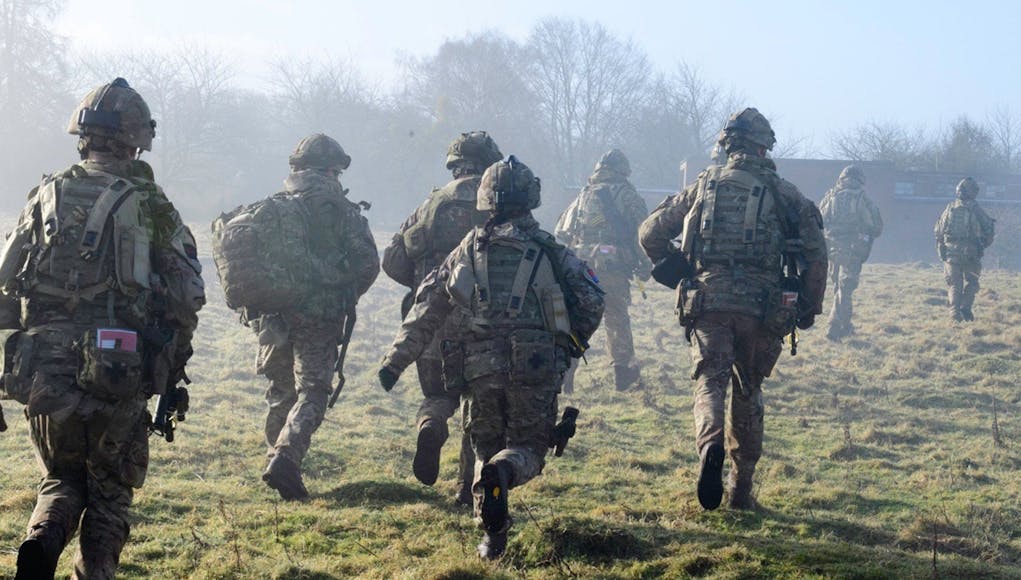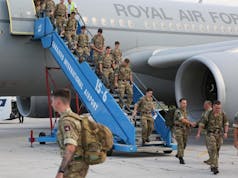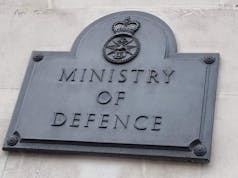Recent data from the Ministry of Defence highlights the performance of soldiers in the Role Fitness Test (RFT), revealing consistently high pass rates among both ground close combat (GCC) and non-ground close combat (NON-GCC) troops since the test’s introduction.
Siobhain McDonagh, the Labour MP for Mitcham and Morden, posed a question to the Secretary of State for Defence regarding the number and proportion of soldiers passing, failing, or having other outcomes in the Role Fitness Test each year since its inception. McDonagh specifically inquired about the breakdown between GCC and NON-GCC troops.
The Parliamentary Under-Secretary of State for Defence, Andrew Murrison, provided a detailed response, presenting data from the Army’s Personnel Policy Directorate as of May 17, 2024.
Murrison’s response outlined the annual performance of Regular and Reserve soldiers in the Role Fitness Test:
2021:
- GCC: 469 failed, 15,479 passed, 3% failure rate, 97% pass rate
- NON-GCC: 615 failed, 14,617 passed, 4% failure rate, 96% pass rate
- Total tested: 31,180
2022:
- GCC: 458 failed, 17,381 passed, 3% failure rate, 97% pass rate
- NON-GCC: 1,050 failed, 32,223 passed, 3% failure rate, 97% pass rate
- Total tested: 51,112
2023:
- GCC: 503 failed, 18,617 passed, 3% failure rate, 97% pass rate
- NON-GCC: 1,129 failed, 35,712 passed, 3% failure rate, 97% pass rate
- Total tested: 55,961
2024:
- GCC: 229 failed, 8,378 passed, 3% failure rate, 97% pass rate
- NON-GCC: 440 failed, 15,250 passed, 3% failure rate, 97% pass rate
- Total tested: 24,297
Murrison noted that the data, sourced from a live system, could be subject to change and might include data quality issues affecting accuracy. The figures are single service estimates based on management information rather than official statistics produced by Defence Statistics.
The Role Fitness Test (RFT) commenced for Regular Non-GCC troops in September 2021 and for Reserve Non-GCC troops in April 2022, explaining the lower test numbers in these categories for the initial year.














Just to elaborate, the RFT is one of two fitness tests Soldiers currently need to complete (the other being the Soldier Conditioning Review, SCR, completed every six months).
The RFT consists of:
A squadded weighted March, 4km carrying 40kg in 50minutes, to simulate a patrol in CEMO.
A individual best effort 2km, carrying 25kg in under 15 minutes. to simulate advancing to the assault.
Sprints, dropping into prone 10m repetitions for 150m (I think always forget the distance) followed by a 30m leopard crawl and another sprint. To the PTI’s timings, carrying 15kg (all further tasks are carrying 15kg). To simulate assaulting an enemy position
70kg weighted lift, stand on boxes, pick up rope, lift weight above the boxes for 3 seconds. Simulates pulling a casualty out of a AFV.
120kg weight drag. 60m over 30 seconds. Simulating pulling a casualty out of contact.
40kg jerry can carry over 280m, in under 4minutes. Simulates carrying a casualty on a stretcher.
20x 30m shuttles carrying a 20kg sandbag alternating with 20x30m shuttles without the sandbag. Simulates carrying supplies or sandbags from a vehicle to a position.
Exact weights, times and distances vary by capbadge and job role, individual components are done sequentially, with a short rest between each to take water on board. The entire test can take anywhere from two and a half to four hours depending on how many PTI’s and Pax being tested there are.
On the whole the new test looks quite good with a decent bit of thought into it
Indeed. Combined with tbe SCR (which isn’t strictly Pass/Fail and more designed to identify weaknesses to be rectified) I think it’s pretty decent.
Thanks for that.
Thanks Dern for the very useful info. It certainly is a very thorough process.
Only thing is it does drag. By the time you reach the 70kg dead lift you just want it to end 😂
Also if the numbers are off you can get cold waiting your turn which is not fun.
It seems to me the army has overcomplicated a simple fitness test I served for 24 years and we just did bft and cft and a beep test
The PFA/BFT has always been a bit of a terrible test. It only ever tested if you where a quick runner in trainers, and the AFT/CFT also became pretty irrelevant.
Now the actual fitness test is designed to replicate a deliberate assault followed by a casevac (where individual fitness counts most), while the SCR is specifically designed to monitor where your physical strengths and weaknesses lie, and provide PTI staff a chance to correct any underlying issues.
That’s fair enough I guess I still work for the army as a civil servants and I have seen some soldiers that can’t pass the hot plate in the cookhouse let alone any fitness test . When I joined the but was done in boots and lightweight trousers I never saw the point of going to trainers
I think it got changed to trainers to reduce the occurrence of MSKIs. They compensated by making the run time lower.
Yes shin splints were a common injury back then
why the test number 20,000 below army total personnal numbers, can not be 20,000 down graded or P7, So by those numbers 28% ish of the Army were not tested each year, or am i miss reading the figures?
Read my above post, an RFT is a major test to run, requiring a lot of time to be set aside by both the PTI’s and tested PAX.
So the 19,000 includes; anyone who is downgraded (already a big percentage). Anyone who completed a test in, for example, november or december of 2022, and when they became “red” for RFT there wasn’t another one running for a few months into 2024 (I was red on my RFT for 3-4 months waiting for my unit to run one this year), and, anyone in a pid that won’t require deploying might not pursue doing an RFT particularly vigorously (think for example someone doing recruiting) and miss it for a year or two.
Remember that in addition to the RFT there is also the SCR, which I suspect will have a much higher attendance rate, taking up only about an hour, rather than 3-4.
(Edit: A quick check shows that 11% of the Army was MLD or MND in 2019, so if that number holds steady, it’s 17% of the army that has avoided an RFT in any given year)
it this test easier than CFT/BFT/BPFA/ICFT ie why was it brought in? i always felt some test were simply brought in to get higher pass rate/ fiddle the books but saying that not having ever taken this test its after my time.
Martin, I litterally outlined the exact requirements for GCC’s to pass the RFT above. I’m not going to retype the entire thing.
Well done you, enjoy the afternoon.
Grow up.
So angry, you need a hug? i can never grow up, a bit like Peter Pan. Please get over your self and remember not ever one is one of your soldiers to boss about, some of us have done our time and can talk normally with out talking down to people.
Rank may matter in the Army not on here. Please enjoy the rest of the day. and evening.
Wow this is pathetic. You can’t even deal with someone pointing out that the answer to your question is higher up in the thread without having a temper tantrum and trying to get personal?
As I said: Grow up. Learn to have an adult conversation. Maybe posting isn’t for you?
really, ii was asking if it wasenjoy your day,
Unfortunately not, the question was are the new tests easier or harder than the old CFT ect. A subjective comparison by someone having done both types was required not a finger point to your previous statistical analyses.
Martin, it’s a fair question. The short answer is the standards have been lowered. The new standards have changed the mentality of troops, we are seeing a vast change in the physical robustness of soldiers as they don’t have to train hard to meet the requirements. The old method wasn’t perfect by a long shot, but most could not train for a year and still pass the SCR and RFT.
That is the major issue the military has gone soft and fat because it has to to get people to join, bad idea and it will come back one day and bite. Old days were ok, hard, rough but i always thought fair.
Harder you train the better you fight, its a worry about if the Army is up to the job regardless of kit issues. I find most step up when they had to.
LMFSO 😎
Get some coverage on here of today’s story in the news about the recruit rejected due to a small chance of her carrying a gene linked to best cancer. Another example of the ridiculous excuses used to reject perfectly capable applicants that could serve well for years. And this comes at a time when recruiting is allegedly a problem! As usual its a self inflicted problem.
Yes its daft , let the actual recruits course decide who is fit to pass . How many individuals who started out of shape over weight ,illiterate and complete belle’s became excellent soldiers and or a better version of themselves 🙂
The problem is you occasionally get someone in who then dies of a heart condition during a training run.
Excellent explanation Dern, thanks, it looks a useful and practical system. Identifying performance aspects that individuals need to work on or be helped with is a good approach,, both for the individual and the overall standard of army fitness.
What is a PID, don’t remember that one? Forgive me if you have already covered that.
Hey, no worries.
I’m afraid I don’t know what the Acronym PID is short for, but what it is: A PID is a position that a soldier can be assigned too. For example an Infantry section would have a PID for a Cpl, one for a LCpl, one for a GPMG gunner, etc.
So in this context for example: A PID that can’t deploy might be a recruiting sergeant.
Thanks, PID was one that I too was always unsure of, but was on the right track with my assumption.
PID, simply personnel identification.